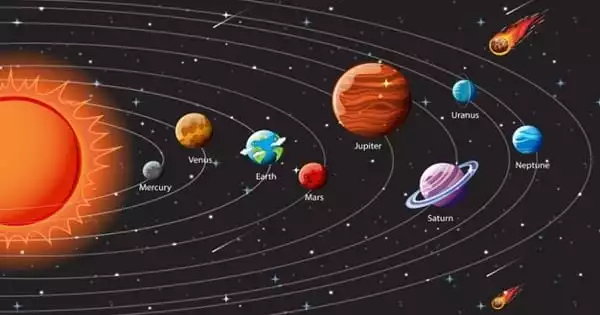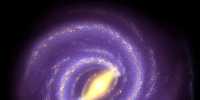Cosmochemists have published the most extensive analysis of the isotopic compositions of Earth, Mars, and virgin building material from the inner and outer Solar Systems to date. Earth and Mars were constructed primarily from material that originated in the inner Solar System; just a small percentage of these two planets’ building blocks originated outside Jupiter’s orbit.
These discoveries were published today in the journal Science Advances by a group of academics lead by the University of Münster (Germany). They give the most thorough study of the isotopic compositions of Earth, Mars, and virgin construction material from the inner and outer Solar Systems to date. Some of this material can still be found in meteorites today, largely undamaged. The study’s findings have far-reaching implications for our understanding of the processes that generated the planets Mercury, Venus, Earth, and Mars. The notion that the four rocky planets developed to their current sizes by collecting millimeter-sized dust pebbles from the outer Solar System is untenable.
A disk of dust and gases orbited the newborn Sun approximately 4.6 billion years ago in the early days of our Solar System. Two ideas explain how the inner rocky planets developed over millions of years from this primordial construction material. The dust in the inner Solar System agglomerated to ever larger chunks, eventually reaching the size of our Moon, according to the older idea.
We wanted to know if the building blocks of Earth and Mars originated in the outer or inner Solar System. To that purpose, isotopes of the rare metals titanium, zirconium, and molybdenum discovered in minute traces in the outer, silicate-rich layers of both planets provide vital insights. Isotopes are distinct forms of the same element that differ solely in the weight of their atomic nucleus.
Dr. Christoph Burkhardt
Collisions between these planetary embryos resulted in the formation of the inner planets Mercury, Venus, Earth, and Mars. A contemporary idea, on the other hand, proposes a distinct growth process: millimeter-sized dust “pebbles” traveled from the outer Solar System to the Sun. They accreted onto the planetary embryos of the inner Solar System on their voyage, gradually enlarging them to their current size.
Both hypotheses are based on theoretical models and computer simulations that attempt to reconstruct the environment and dynamics of the early Solar System; both outline a plausible path of planet formation. But which is correct? Which procedure actually occurred? Researchers from the University of Münster (Germany), the Observatoire de la Cote d’Azur (France), the California Institute of Technology (USA), the Natural History Museum Berlin (Germany), and the Free University of Berlin (Germany) determined the exact composition of the rocky planets Earth and Mars in their current study.
“We wanted to know if the building blocks of Earth and Mars originated in the outer or inner Solar System,” explains Dr. Christoph Burkhardt of the University of Münster, the study’s first author. To that purpose, isotopes of the rare metals titanium, zirconium, and molybdenum discovered in minute traces in the outer, silicate-rich layers of both planets provide vital insights. Isotopes are distinct forms of the same element that differ solely in the weight of their atomic nucleus.
Meteorites as a reference
Scientists believe that these and other metal isotopes were not uniformly distributed in the early Solar System. Rather, their abundance was proportional to their distance from the Sun. As a result, they provide significant information on where a particular body’s building pieces originated in the early Solar System.
The researchers employed two types of meteorites as a reference for the original isotopic inventory of the outer and inner Solar Systems. These fragments of rock generally made their way to Earth from the asteroid belt, which is the region between Mars and Jupiter’s orbits. They are thought to be mostly pristine material from the Solar System’s early days. While carbonaceous chondrites, which can contain up to a few percent carbon, formed beyond Jupiter’s orbit and were only later relocated to the asteroid belt due to the influence of the growing gas giants, their more carbon-depleted cousins, non-carbonaceous chondrites, are true inner Solar System children.

The precise isotopic composition of Earth’s accessible outer rock strata, as well as that of both types of meteorites, has been researched for some time; however, no comparable extensive analyses of Martian rocks have been conducted. The researchers studied samples from a total of 17 Martian meteorites, which may be classified into six categories of Martian rock in their current study. Furthermore, the researchers analyzed the abundances of three separate metal isotopes for the first time.
Martian meteorite samples were first pulverized and subjected to a sophisticated chemical processing. The researchers were subsequently able to detect minuscule levels of titanium, zirconium, and molybdenum isotopes using a multicollector plasma mass spectrometer at the University of Münster’s Institute of Planetology. They next ran computer simulations to determine the ratio of building materials found today in carbonaceous and non-carbonaceous chondrites that must have been absorbed into Earth and Mars in order to recreate their measured compositions.
In doing so, they took into consideration two different periods of accretion to account for the differing histories of titanium and zirconium isotopes, as well as molybdenum isotopes. Molybdenum, unlike titanium and zirconium, accumulates primarily in the metallic planetary core. The trace amounts observed now in the silicate-rich outer layers can thus only have been contributed during the planet’s last stages of formation.
The findings reveal that the outer rock layers of Earth and Mars have little in common with the outer Solar System’s carbonaceous chondrites. They make up just approximately 4% of the initial building blocks of both worlds. “If early Earth and Mars were mostly made up of dust grains from the outer Solar System, this figure should be about 10 times higher,” says Prof. Dr. Thorsten Kleine of the University of Münster, who is also the director of the Max Planck Institute for Solar System Research in Göttingen. “As a result, we cannot corroborate this notion of inner planet creation,” he continues.
Lost building material
The composition of Earth and Mars, however, does not exactly match the material of non-carbonaceous chondrites. According to the computer calculations, another type of building material must have been used as well. “The isotopic makeup of this third type of building material, as suggested by our computer models, means it must have originated in the Solar System’s innermost area,” explains Christoph Burkhardt. Because asteroids in such close proximity to the Sun were virtually never thrown into the asteroid belt, this material was nearly totally absorbed by the inner planets and so does not exist in meteorites. “It’s a ‘lost building material,’ so to speak, to which we no longer have direct access today,” explains Thorsten Kleine.
The unexpected discovery has no bearing on the study’s implications for the theory of planet creation. “The fact that Earth and Mars appear to be mostly composed of material from the inner Solar System fits well with planet formation from collisions of massive planets in the inner Solar System,” Christoph Burkhardt concludes.
















